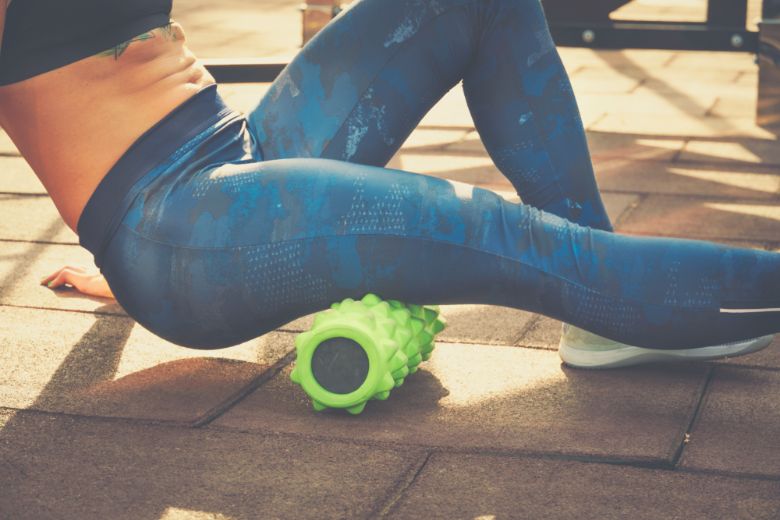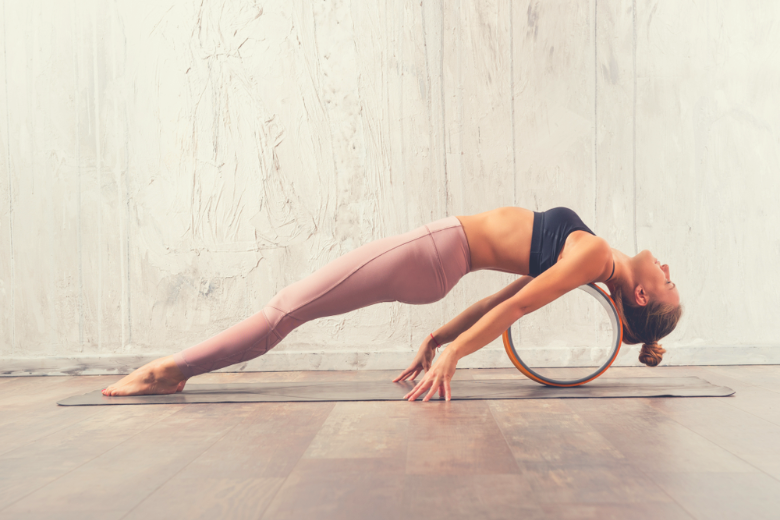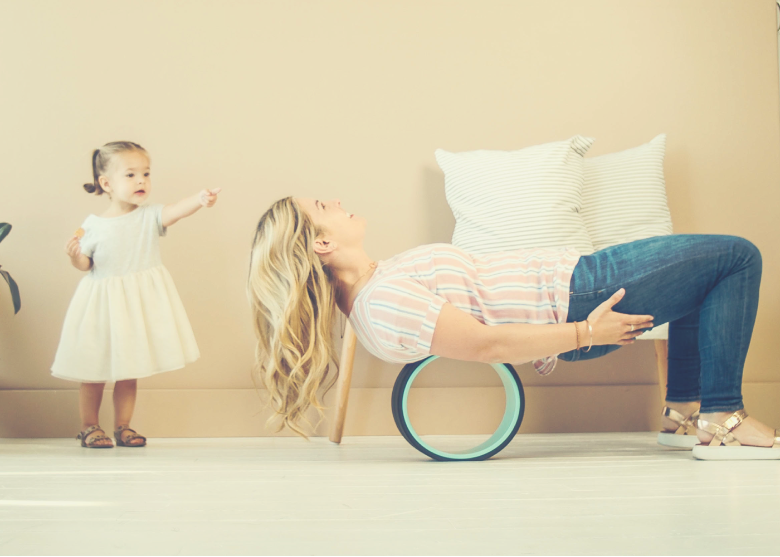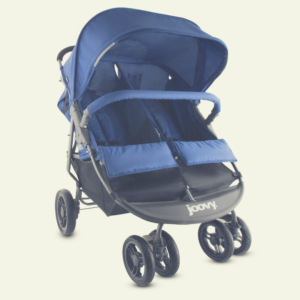If you’re anything like me, mornings are a pain in the back! If I don’t take care of my sore muscles, it can take me up to half an hour to get out of bed.
Luckily, there are ways to relieve back pain at home without breaking the bank, like a yoga wheel or foam roller. But how do you know which tool is right for you?
What is a Foam Roller?
A foam roller is just what it sounds like: a cylindrical tool made of foam.
Self-myofascial release is the fancy term for a roller’s function, which is a self-massage to relax tight muscles.
Applying pressure to points on your body allows you to assist your muscles in the recovery process.
Normal muscle function means you can do everyday activities at a reasonable speed and perform an action spontaneously without pain.
Professional athletes rely on this technique all the time, so we know there’s something to it!
Foam rolling also works well as part of your warm-up and cooldown routines, even when you haven’t injured your muscles.
A small study followed eight physically active men who performed 20 minutes of foam rolling after their normal exercise routine.
This study shows evidence that rolling can reduce delayed-onset muscle soreness.
Pros of a Foam Roller
A study following 11 athletes who combined static stretching with foam rolling. Compared to each activity on its own, the combination shows lots of promise.
Foam rolling can relieve:
- muscle soreness
- tightness
- inflammation
- limited joint range of motion
Cons of a Foam Roller
Using a foam roller is not unlike giving yourself a deep tissue massage.
Usually, someone else works the knots out of your back, and sometimes it hurts. With a foam roller, you can control your focus on the massage and hold back when it hurts.
Always take care when you’re rolling on your back; it’s easy to injure yourself, especially if you’re already hurt in the first place.
For best results, roll the tube parallel to your spine slowly. Trying to push horizontally causes you to arch your back, putting unnecessary strain on it.
It’s also a good idea to talk to your doctor or physical therapist before starting a rolling foam routine.
Although rollers can help with sore muscles, they do come with drawbacks:
- Too much pressure can hurt
- The benefits take a while to appear
- Improper use can lead to an injury
Who Should Buy a Foam Roller?
Most people should be able to use a foam roller for fitness and massage. Like I said before, talking with your doctor first is a good idea in case he or she has a concern.
For example, people with chronic back injuries or who are more susceptible to trauma may not want to use a foam roller.
The first time you use a foam roller might feel awkward, but it definitely gets more comfortable as you practice.
Remember to move slowly and apply direct pressure to the knots in your muscles. Moving too quickly can cause severe pain or injury.
What is a Yoga Wheel?
Some people who practice yoga incorporate narrow wheels into their routines.
These so-called yoga wheels are 12 inches in diameter and come in plastic, wood, or a combination of the two.
When used in yoga, the wheels help you deepen your stretches and transition to more advanced poses.
They also provide additional support to help you keep your balance in the most challenging positions. Plus, it just looks impressive to show off once you master it.
Because of the extra support a wheel can offer, it could also help with back stretches. The trick, as always, is to take it slowly to be safe.
Pros of a Yoga Wheel
Aside from building stamina and strength, wheels offer so many benefits.
For starters, it helps you safely stretch more deeply. It’s the perfect shape to ease yourself into a backbend without pulling a muscle along the way.
Likewise, the wheel can prevent other injuries. Think of it like scaffolding that your body can use for support.
You can take advantage of this extra help to complete stretches and poses you couldn’t do otherwise.
To take that a step further, it could help make you more flexible. Incorporating a wheel into your routines gives you the support needed to train your body to stretch further than usual.
Over time, you’ll find your body moving in ways you never imagined!
Certain poses with the wheel can help relieve those nasty aches and pains beyond the back, too. You can even work on your hips, shoulders, chest, and abdomen!
Cons of a Yoga Wheel
It is not as useful for a beginner to use alone for all the benefits that a wheel can offer.
Sure, you can get your own wheel and incorporate it without looking up the proper usage, but there is a chance you could injure yourself.
Trying to perform stretches you’re not used to just because you have a wheel is a potential recipe for disaster.
It’s a little easier to overwork your muscles on the wheel compared to a foam roller.
Still, with a little instruction, and by taking it slowly, you can ease yourself into using your new tool.
Who Should Buy a Yoga Wheel?
There’s a reason yogis and celebrities alike use a wheel in their routines — it works!
Just about anyone can enjoy the many benefits a wheel has to offer. All muscles get a little sore from time to time and need a deep massage.
However, it’s best for those who are flexible enough to perform some basic stretches and poses but want to go further.
If you’re still learning how to bend your back, then a wheel will work well for you.
If you’re already experienced with using blocks and consider yourself a yoga veteran, you might not gain anything new from a wheel.
Foam Roller Buyer’s Guide

Whether you go to the gym regularly or have trouble getting around the house after a long day, you’re probably all too familiar with the feeling of sore muscles.
With all the different foam roller options out there, finding the best one can seem like a puzzle. What are you supposed to look for?
Density
Density is arguably the most essential part of your decision. Different rollers have different levels of firmness.
Very soft rollers may not provide enough pressure to target the knots in your muscles. Still, tight rollers can traumatize the tissues and bruise your body.
Nobody wants to get beat up in the recovery process!
If you’ve never bought a roller before, err on the side of soft. As you get better at using the tool and your muscles adapt to the feeling of pressure, you can upgrade to a higher density.
Soft rollers contain polyethylene foam, which is more comfortable to use, but it warps more easily. Firmer rollers are more durable thanks to their EVA foam makeup.
Denser rollers last longer since they’re more durable. Soft rollers feel better, but they’ll deform faster as you use them.
Feel free to replace your soft roller with another if you’re not ready to upgrade to a harder foam.
There’s a middle ground, of course. You can buy a roller made of EPP foam, which is a relatively inexpensive material that can withstand the pressure from users of all levels.
They’re a good middle ground for those looking to get started with rolling for the first time and for those who are more advanced with the practice.
A roller’s color often hints at its density level. Many brands make their soft rollers white, and their firm rollers black.
In contrast, red and blue rollers usually have medium density. This isn’t guaranteed, though, so make sure you give the roller a squeeze test.
Surface Texture
Aside from density, texture also changes the nature of the massage.
Some rollers have knobs that let you apply more substantial pressure to a targeted area. These textured rollers mimic a masseuse’s hands working specific knots in your back, but at your pace.
Other rollers have no texture to them, producing uniform pressure across the whole surface. This means the overall force isn’t as intense compared to a textured roller with knobs and ridges.
If you’ve never had a roller before, smooth-textured ones are great for beginners.
Shape and Size
Of course, not all rollers come in the same size or shape, either.
Length
Longer rollers measure to about 36 inches. They cover a more full area of the back, making them an excellent choice for a first roller.
They target the entire back when you roll it along your spine. The extra length helps the roller stay in place when massaging your hamstrings, quads, and other muscles.
Shorter rollers are only two feet long, but that makes them great for precision targeting, like the calves or arms. More portable rollers can measure as little as four inches long.
In most cases, a foam roller measures to about six inches in diameter. For most people, this is a comfortable height for starting out with self-massage. Three-inch rollers provide a deeper massage.
Shape
Foam-covered massagers look like rolling pins, and they’re best for precision massage on the legs. This flexible massager can also help target your upper back.
A half-round foam roller looks like a regular roller was bisected the long way. Again, they’re best used for leg stretches.
They can also relieve the cramping from plantar fasciitis in the feet.
Finally, foam balls offer the most precise control over your massage. They work well in the lumbar region and other curved body parts.
Recommended Foam Roller – Trigger Point
If you need recommendations for a foam roller, definitely check out the one from Trigger Point. This foam roller is longer and can accommodate taller people.
We particularly like the color options available to us – orange, pink, black, and camo.
This foam roller is designed for target massages and is constructed with “green technology” and can withstand heavy and repeated use without breaking down.
Yoga Wheel Buyer’s Guide

Truthfully, all yoga wheels kind of look alike. They’re all just a bunch of tiny plastic circles, right?
So why are some so much more expensive than others?
It turns out these little wheels are deceptively simple! Each one differs in its sustainability, maximum weight load, material, and exact size.
In all, there are four primary factors to think about when picking a wheel for yourself.
Weight Limit
Most people won’t have trouble with this part, but it’s always good to double-check.
The majority of yoga wheels for sale can hold up to 500 pounds. Some hold more and can withstand your entire weight even if you’re standing on it. Others are just for light use.
Consider how you plan to use your wheel and scrutinize the weight limit.
If all you want to do is stretch your muscles and get rid of back pain, then a lower weight limit should be no cause for concern.
But if you’re going to stand on the wheel or sit on it for balance, it’s crucial to make sure it can handle your full weight without cracking.
Size
There are three common wheel sizes: standard, mini, and plus.
Standard wheels measure as 12 inches in diameter. Most bodies can use a standard wheel without any worry.
If you’re under 5 feet tall or want to use your wheel for precision massage, then a mini wheel will work for you.
Plus-sized wheels are best for extra-deep stretches or particularly tall users.
In all cases, most wheels measure five inches in width. For muscle release, I find a wheel of this size works best right between the shoulder blades.
But you can find thicker wheels for more stability.
Material
The majority of wheels use ABS or PVC plastic for the frames, but sometimes they use real wood.
Plastic is, of course, very durable and rigid, and it’s cheap to make. In other words, plastic wheels are more comfortable to afford than those made with natural materials like wood.
ABS can handle a higher weight limit compared to PVC.
Don’t be fooled by sellers who claim their inexpensive wheel is eco-friendly. Some brands might cover their wheels with natural cork, but the frame still contains PVC or ABS plastic.
Frames made of natural materials like wood have a lower weight limit compared to plastic.
They are, however, genuinely eco-friendly and biodegradable, but that comes at a cost. You might have a hard time finding a wooden wheel due to these high prices.
Padding
As important as its frame may be, the wheel’s padding is no less critical.
Massaging your tight muscles can be painful, especially if you’re new to the practice. Using a wheel with thicker padding can give your spine a cushion to prevent unnecessary pain.
If you’re sensitive to resting on a hard surface, you’ll find it tricky to get used to a wheel. In that case, I highly recommend getting as thick a pad as you can find.
The choice in padding material mostly comes down to whatever you’d prefer.
Foam padding is sweat-resistant and won’t slip when you’re really into it. Some even come with texture to add extra grip on the surface.
Cork is also slip-resistant and looks more natural compared to other materials.
Of course, you’re probably not going to bring a wheel to a hot yoga session in the sauna, so grip isn’t as big a concern. Pick whatever looks best or whatever you can find!
Shape
Believe it or not, but not all wheels are circles!
It is, of course, the most common shape. However, using a standard wheel without any experience can feel very harsh on the spine.
If you find this is true for you, you can look at elliptical wheels instead. This design offers two surfaces to roll your back on: a flatter curve for muscle release, and a rounded curve for a deeper stretch.
The main benefit of an elliptical wheel is that it more comfortably conforms to your spine.
It’s still practical for other uses, too. You can even use an elliptical wheel for forearm stands, to improve your posture, or to practice your balance.
It just adds support and stability for your safety.
More advanced users might find half-wheels interesting for deeper backbends.
Back benders also work well for those who aren’t looking for core training or to improve their balance.
They’re just as useful as a standard wheel without wobbling underneath your body the whole time.
In fact, they may also be just the right tool to help correct your posture.
Recommended Yoga Wheel – Chirp Wheel

If you’re looking for a recommendation for a yoga wheel, we cannot say enough about the Chirp Wheel.
So what makes this yoga wheel so special? Well, to start, it’s the only wheel on the market that is FDA-registered as a 510(k) medical device.
This yoga wheel also features a Spinal Canal that stretches the muscles around the spine for a deeper stretch than you’ll find with most other yoga wheels.
> > Read Our Full Chirp Wheel Review Here < <
Final Thoughts
To recap, foam rollers and yoga wheels both provide lots of benefits for those with muscle pains.
If you’re a chronic sloucher or worry that you sit at your desk too much each day, you’d likely benefit from either tool.
Either way, be sure to take the new exercise slowly to be safe. Hold back if you start to feel too much pain. Work your way up gradually to prevent injury.





